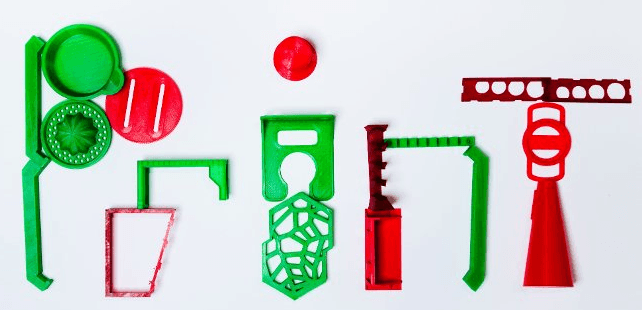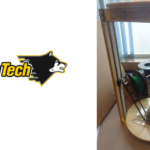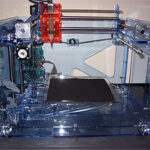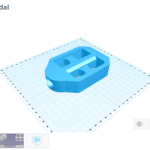

What originally began as a school to train mining engineers in the late 1880s has grown into a leading tech university, where 3D printing has been on the curriculum for several years. Michigan Technological University (MTU) teamed up with America Makes last summer to develop an open source, web-based 3D controller, and the university’s research and development work with open source 3D metal printing has even inspired other universities to create 3D metal printers. A group of MTU students launched a biodegradable filament business, and MTU researchers have worked with everything from 3D bioprinted nerve tissue to a solar-powered 3D printer. Open source 3D printing advocate and MTU professor Dr. Joshua Pearce, who is often engaged in 3D printing, introduced and taught an extremely popular engineering class in 2015, called “Open Source 3D Printing,” and even wrote the textbook for the class.
Dr. Pearce wanted to figure out how cost-effective and practical it was for the average consumer to invest in a desktop 3D printer and use it at home. In a study, titled “Emergence of Home Manufacturing in the Developed World: Return on Investment for Open-Source 3-D Printers,” that was recently published in MDPI’s international open access Technologies, he was able to determine that when consumers buy a low-cost, open source 3D printer and use it at home to create household items, over a five-year period, they can actually earn an almost 1,000% return on their investment. Even consumers who aren’t as tech-savvy as some can make back the original cost within six months. To help him compile research data, Dr. Pearce tapped an undergraduate student, majoring in both engineering and materials science but inexperienced in 3D printing, to use a low-cost 3D printer right out of the box, without receiving any instruction first.
Undergraduate student Emily Petersen said, “I’d never been up close and personal with a 3D printer before. And the few printers I had seen were industrial ones. I thought learning to operate the printer was going to take me forever, but I was relieved when it turned out to be so easy.”
Petersen decided to use a LulzBot Mini, which retails for less than $1,500 and is a popular option for the desktop: according to Aleph Objects, it was built to work right out of the box. It took Petersen about thirty minutes to set up the LulzBot Mini, and then she got right to work, searching on 3D design file search engine Yeggi for a total of 26 everyday, popular household items to print.
Dr. Pearce said, “You search, select, and hit print, just like a regular computer and office paper printer.”
Petersen printed an object a week, for a total of six months; this was the conservative assumption for how much an average household might use a 3D printer. She only used 3mm PLA, which is the most commonly used filament in households because it demonstrates less warping, has less pungent emissions, and is biodegradable. According to the study, Dr. Pearce used three separate criteria to choose the products:
- Printable by a LulzBot Mini in PLA, in terms of appropriate resolution, build volume, and material requirements
- Widely considered a common product, or class of product, purchased or owned by the average American consumer
- Features a commercially comparable alternative product available for online purchase
In order to demonstrate how easy it was to use, Petersen didn’t worry about optimizing the printer’s slicer settings and just used the default QuickPrint settings in the LulzBot Mini’s version of Cura software. She printed uncomplicated items like tool holders, GoPro camera mounts, cell phone cases, shower heads, and snowboard binder clips, though she says her favorite was a fan-art Pokemon Bulbasaur planter. Once Petersen had finished printing all 26 items, she and Dr. Pearce got to work on the economic analysis portion of the study.

To determine an item’s overall cost, the two had monitored and recorded the energy, plastic use, and overall print time for each one using a multimeter, and then completed a per-item savings analysis; check out the study if you’re interested in seeing how the math shakes out, because heaven knows I won’t be able to explain it. Dr. Pearce and Petersen also ran high-cost and low-cost comparisons for each item, both of which showed an average savings of over 90%. They mainly relied on Walmart.com and Google Shopping to determine the commercial prices for all of the products.
“With the low-cost estimates, the printer pays for itself in three years and all the costs associated with printing-such as the price of plastic and electricity-are not only earned back, but provide a 25 percent return on investment. After five years, it’s more than 100 percent. With the high-cost estimates, the printer pays for itself within six months. And after five years, you’ve not only recouped all the costs associated with printing, you’ve saved more than $12,000,” said Dr. Pearce.
He says that it’s reasonable to assume a five-year life cycle for the LulzBot Mini, mostly because it’s open source and any files needed to upgrade or fix it are free online. In fact, a lot of the parts that are most likely to break are actually 3D printable themselves right at home – no trudging into the Apple store’s Genius Bar and asking for help, or trying to get through to a customer service rep on the phone.
Petersen hopes that her experience will give other people more confidence to try 3D printing at home, which she and Dr. Pearce both agree can only get easier as the technology continues to develop and more open source 3D printable designs become available online (though there are already millions out there).
“I’m an engineering student, but I was new to this type of hands-on troubleshooting. The fact that I was able to troubleshoot any issues I had and produce 26 items relatively easily is a testament to how accessible this technology is to the average American consumer,” said Petersen.
Take a look at this short video to see Petersen putting the LulzBot Mini through its paces:
According to a recent CONTEXT report, desktop 3D printers are in high demand at the moment. While consumers are not the primary users of most desktop 3D printers (think small businesses and professional designers), these users may indeed be seeing more use for them as we go forward. Imagine the possibilities: if you break your cell phone case, or need a new shower head, instead of buying it online or driving to the store to replace it, you can make new ones from the comfort of your own home. This helps make consumers more self-reliant and independent, and could even potentially cut down on our carbon footprint if we can reduce truck deliveries and trips to the mall for only one thing. As listed at the end of the study’s abstract, Dr. Pearce estimates that by only using the 26 objects analyzed in the study, consumers who engage in at-home 3D printing may be able to save more than $4 million. So, what are you waiting for? Discuss in the At-Home 3D Printing forum at 3DPB.com.
[Sources: Michigan Tech News, Technologies]
When it comes to 3D real estate visualization in the USA, our service provides the perfect solution for bringing property listings to life. Through our platform, you can easily access cutting-edge 3D renderings that showcase your real estate projects in a way that attracts potential buyers and investors. Whether it's residential, commercial, or mixed-use properties, our team of experts uses advanced technology to create immersive visualizations that highlight the best features of your property, making it easier for clients to imagine the space as their own.
Through our website, you can quickly get high-quality 3D real estate visualizations that are tailored to your specific needs. With our help, you'll stand out in the competitive real estate market by offering potential buyers a realistic, interactive view of your property. Our efficient process ensures a fast turnaround time, while our attention to detail guarantees that every aspect of the property is represented accurately, giving you a powerful marketing tool to promote your real estate listings.






